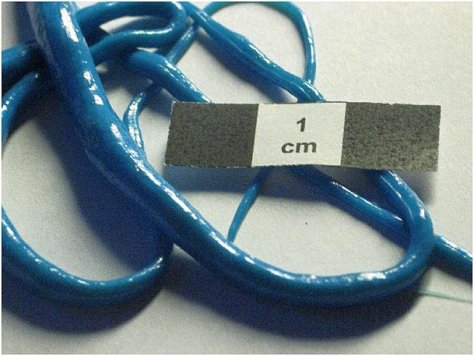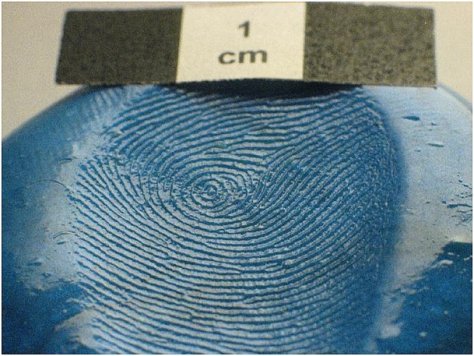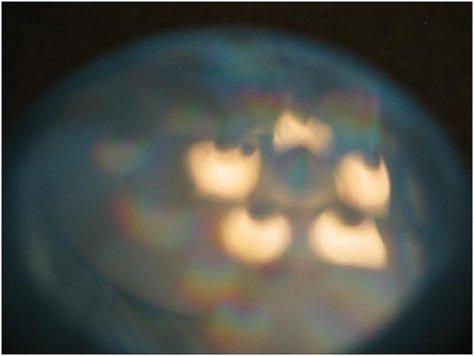The most useless material
Text and photos: Jaak Kikas, TU Institute of Physics, Tartu
Translation: Liis
Photo 1. Thinking Putty flowing through hole in jar cover. In spite of its name, it probably doesn’t think much in the process :).
Second World War: victorious Japan is rapidly widening its territories, conquering a number of countries that are important rubber (caoutchouc) producers. The scarcity of rubber is sharply felt in USA; people are urged to use rubber products economically, and to donate them for the use of the army. Government encourages investigations of synthetic replacements for natural rubber. Earl Warrick at the newly established Dow Corning, and inventor James Wright at General Electric were both working on this. A quotation from J. R. R. Tolkien fits nicely as a description of what happened: “There is nothing like looking if you want to find something. … You certainly usually find something if you look, though it may not be quite the something you were after.” (The Hobbit, 1937). Both men discovered, independently of each other, that if boric acid is added to silicon oil (a synthetic silicon compound), a material with very peculiar elastic properties is formed. On kneading it can be formed like plasticine, it even spreads out by its own weight. If a small ball of “Silly Putty”, as the material is known, is put on a table, with time it will end up as a “pancake”. But when the same ball is thrown on the floor it bounces back like a rubber ball. And the material fractures into pieces from a sharp hammer blow. It might be thought that such an interesting material would have many practical uses. But regrettably … up to today none have been found. The demonstrations of its own properties have remained the only uses of Putty. Several companies market it under different names (such as Thinking Putty, Bouncing Putty, Potty Putty) as an exotic fancy material. A more detailed review of the history of Silly Putty is in the Wiki article with the same title. Considering its physical properties Putty is a highly viscous liquid. But a liquid with very peculiar properties. The viscosity of most ordinary liquids (water, oils etc) is not dependent on how fast they are stirred. Such liquids are known as Newtonian liquids – the great scientist made a contribution even in this area. At the same time so-called non-Newtonian liquids are also known, where the flow properties are strongly dependent on the flow rate. The viscosity of Silly Putty increases with an increasing deformation rate – to the extent that it begins to behave as a rigid solid body (fragments from a hammer blow!). At the same time liquids are known where the viscosity decreases as the flow rate increases. Such are for instance the so-called thixotropic paints. They can be easily applied on to a surface with a paintbrush, but they will not begin to flow by their own weight, even when applied as a quite thick layer on a vertical surface; the paint layer retains a uniform thickness.
What, then, can be done with Putty?
Some experiments have already been indicated. Some more:
- Shape Putty into a small “sausage” and pull at the ends. Pulling slowly you can get a very long “putty thread”, with a sudden pull however putty breaks at once, leaving smooth fracture surfaces (Photos 2, 3).
- Impressions: Press a piece of Putty against a colour print in a newspaper. When the piece is removed you will notice that there is a colour impression on its surface (for this experiment white Putty is useful). And this can be deformed at will by pulling at the piece or compressing it (weight reduction in seconds!). Put plainly, do the same tricks manually that can be done in a computer with image morphing software. Actually Putty does not only pick up colour but also the texture of the surface, but sadly this impression does not last for long due to the flow of the material (Photos 4, 5).
In the “Materjalimaailm” (World of Materials) article “Silly Putty” you can find more ideas for experiments. Maybe you will even discover some truly practical use for this queer substance? It may be added that Putty in itself is a colourless substance. But to make “puttymania” more colourful the producers have added various colours – even such glowing in the dark.
Where to buy it? The author has no information on whether any hobby shop in Estonia sells putty. It can certainly be bought on Internet, for instance at the URL http://www.puttyworld.com/ (but also from many other sources).
Happy puttying!
Photo 2. On fast pulling the “putty sausage” breaks off like this …
Photo 3. … with slow pulling it can be stretched to become very long and thin.
Photo 4. Fingerprint on Thinking Putty surface. But the detective needs to be quick – the print will not remain for long.
Photo 5. But the “queer putty” can manage even more intricate feats. The photo shows lamps in the ceiling, mirrored in a smoothed Thinking Putty surface. But from where are the coloured “shadows”? They are diffraction images from the lamps: a relief diffraction grid, with a grid distance of only a few microns, was pressed against the Thinking Putty surface. For a short time the Putty surface will retain even such a delicate impression.













